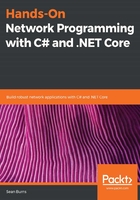
Ring topology
A ring topology is very similar to a linear topology (which, as I noted before, is technically an implementation of the bus topology) except that, in the case of a ring topology, the endpoints are ultimately connected, and communication is unidirectional, as shown in the following diagram:

The benefit of this particular network topology might not be immediately apparent, but with each node in the network serving as a peer of the previous node in the chain, there's no need for any request broker, or communication specific software or hardware. This can lower your network management costs substantially.
The drawbacks are similar to each of the previous implementations in that, once a link in the chain is broken, the network is essentially rendered useless. Technically, because of the unidirectional communication pattern of a ring topology, the node residing immediately after the broken link in the chain can still communicate with every other node in the network, and maintain some degree of operation. However, since any responding device would be incapable of transmitting their response back to the originating node, communication would be one-way for all nodes on the chain. I'm having an extremely hard time imagining a scenario in which a device on a network can meaningfully interact with a distributed system via strict one-way communication.
Another less obvious downside to this is that the maximum performance of the whole network would be limited by the lowest performing link between any two nodes in the network. This is the case because any round-trip communication of request-response between two nodes would necessarily traverse the whole chain.